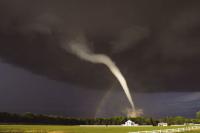-
Seeding iron on the Pacific’s floor may not pull carbon from air as thought
Scientists plumbing the depths of the central equatorial Pacific Ocean have found ancient sediments suggesting that one proposed way to mitigate climate warming — fertilizing the oceans with iron to produce more carbon-eating algae — may not necessarily work as envisioned.
-
-
Four African innovators selected for engineering innovation prize
Following an open, competitive, application process which saw entries from fifteen countries in sub-Saharan Africa, twelve African entrepreneurs were chosen to receive a package of six months of business training and mentoring from the U.K.’s Royal Academy of Engineering. The four finalists showing the greatest promise have now been chosen, and are in with a chance to become the overall winner. Each will receive at least £10,000 with the grand prize of £25,000 to be awarded at a ceremony in Cape Town on 1 June. A low-cost sustainable water filter system to provide clean and safe drinking water, and a service that allows African mobile phone users to switch easily between multiple mobile networks are among the four African innovations selected by the Academy.
-
-
Syria’s 1998-2012 drought likely its most severe in more than 900 years

In the years before the Syrian conflict erupted, the region’s worst drought on record set in across the Levant, destroying crops and restricting water supplies in the already water-stressed region. A new study shows that that drought, from 1998 to 2012, was not just the most severe in a century of record-keeping — it was the Levant’s most severe drought in at least 500 years and likely more than 900 years.
-
-
Applications solicited for funding of next-gen first-response technologies
DHS Science and Technology Directorate (S&T) says that applications are now being accepted through 9 March 2016 for the NextGen First Responder Technologies solicitation, an opportunity for joint-funding by DHS S&T and their partners in the Israeli Ministry of Public Security.
-
-
Groundwater deficit growing in important western U.S. aquifers
By 2050, climate change will increase the groundwater deficit even more for four economically important aquifers in the Western United States, a new report says. Groundwater deficits are expected to worsen in four important aquifers, creating a precarious balance between usage and recharge. The new report is the first to integrate scientists’ knowledge about groundwater in the American West with scientific models that show how climate change will affect the region.
-
-
Outbreaks of extreme tornados have become more common

Most death and destruction inflicted by tornadoes in North America occurs during outbreaks — large-scale weather events that can last one to three days and span huge regions. The largest outbreak ever recorded happened in 2011. It spawned 363 tornadoes across the United States and Canada, killing more than 350 people and causing $11 billion in damage. A new study shows that the average number of tornadoes per outbreak has grown by more than 40 percent over the last half century. The likelihood of extreme outbreaks — those with many tornadoes — is also greater.
-
-
Climate change impact on food production could cause 500,000 extra deaths in 2050
Climate change could kill more than 500,000 adults in 2050 worldwide due to changes in diets and bodyweight from reduced crop productivity. The research, published yesterday in The Lancet, is the strongest evidence yet that climate change could have damaging consequences for food production and health worldwide. The study found that by 2050, reduced fruit and vegetable intake could cause twice as many deaths as under-nutrition, and that three-quarters of all climate-related deaths due to changes in food production are estimated to occur in China and India.
-
-
DHS, DoE, U.S. Army test operational effectiveness of technology solutions
Understanding the true potential of a new technology comes with the opportunity to deploy it in a real life, urban environment scenario against adaptive adversaries. Recently, the Department of Homeland Security (DHS) Science and Technology Directorate (S&T) collaborated with the U.S. Army to assess the operational effectiveness of twenty-five technologies through practical application.
-
-
Making sure that if extraterrestrial observers called, somebody hears
The question of contact with others beyond Earth is hardly hypothetical, as several projects are under way, both to send signals from Earth and to search for signals that have been sent directly or have “leaked” around obstacles, possibly travelling for thousands of years. As scientists step up their search for other life in the universe, two astrophysicists are proposing a way to make sure we do not miss the signal if extraterrestrial observers try to contact us first.
-
-
Water storage strategies in Sub-Sahara Africa

Direct abstraction of water from rivers through ponds and pumping devices seems the most attractive water storage option in Ethiopia. However, the funding agencies that may be interested in investing in such a storage system have to consider that better access to credit, and clear abstraction policies should be ensured.
-
-
In emergencies, don’t trust a robot too much

In emergencies, people may trust robots too much for their own safety, a new study suggests. In a mock building fire, test subjects followed instructions from an “Emergency Guide Robot” even after the machine had proven itself unreliable — and after some participants were told that robot had broken down.
-
-
Calculating monetary losses from floods caused by sea level rise
Damages from extreme events like floods are even more relevant than the mean sea level itself when it comes to the costs of climate impacts for coastal regions. However, while it is now rather well understood how sea-levels will rise in the future, only small progress has been made estimating how the implied damage for cities at the coasts will increase during the next decades. Scientists now provide a method to quantify monetary losses from coastal floods under sea-level rise. For the first time, the scientists show that the damage costs consistently increase at a higher rate than the sea-level rise itself.
-
-
Suicide bomb detector moves close to commercialization with Sandia engineer’s help
On the chilling list of terrorist tactics, suicide bombing is at the top. Between 1981 and 2015, an estimated 5,000 such attacks occurred in more than 40 countries, killing about 50,000 people. The global rate grew from three a year in the 1980s to one a month in the 1990s to one a week from 2001 to 2003 to one a day from 2003 to 2015. R3 Technologies and a group of other small businesses are developing a way to prevent suicide attacks by detecting concealed bombs before they go off. R3 found a partner in Sandia sensor expert JR Russell who has helped bring the company’s Concealed Bomb Detector, or CBD-1000, close to commercialization over the past two years.
-
-
Studying collaboration between research, intelligence communities
In 2013, NC State University and the National Security Agency (NSA) created the Laboratory for Analytic Sciences (LAS) — a collaborative partnership focused on addressing the research challenges associated with “big data.” They soon discovered that a funny thing happens when academic researchers collaborate with the intelligence community: they feel like they are being spied on.
-
-
Fast, lightweight autonomous air vehicle completes first flight data tests
DARPA’s Fast Lightweight Autonomy (FLA) technologies could be useful in addressing a pressing surveillance shortfall. Military teams patrolling dangerous overseas urban environments, and rescue teams responding to disasters such as earthquakes or floods, currently can use remotely piloted unmanned aerial vehicles (UAVs) to provide a bird’s-eye view of the situation, but to know what is going on inside an unstable building or a threatening indoor space often requires physical entry, which can put troops or civilian response teams in danger.
-
More headlines
The long view
Are We Ready for a ‘DeepSeek for Bioweapons’?
Anthropic’s Claude 4 is a warning sign: AI that can help build bioweapons is coming, and could be widely available soon. Steven Adler writes that we need to be prepared for the consequences: “like a freely downloadable ‘DeepSeek for bioweapons,’ available across the internet, loadable to the computer of any amateur scientist who wishes to cause mass harm. With Anthropic’s Claude Opus 4 having finally triggered this level of safety risk, the clock is now ticking.”
A Brief History of Federal Funding for Basic Science
Biomedical science in the United States is at a crossroads. For 75 years, the federal government has partnered with academic institutions, fueling discoveries that have transformed medicine and saved lives. Recent moves by the Trump administration — including funding cuts and proposed changes to how research support is allocated — now threaten this legacy.
Bookshelf: Preserving the U.S. Technological Republic
The United States since its founding has always been a technological republic, one whose place in the world has been made possible and advanced by its capacity for innovation. But our present advantage cannot be taken for granted.
Autonomous Weapon Systems: No Human-in-the-Loop Required, and Other Myths Dispelled
“The United States has a strong policy on autonomy in weapon systems that simultaneously enables their development and deployment and ensures they could be used in an effective manner, meaning the systems work as intended, with the same minimal risk of accidents or errors that all weapon systems have,” Michael Horowitz writes.
Ukraine Drone Strikes on Russian Airbase Reveal Any Country Is Vulnerable to the Same Kind of Attack
Air defense systems are built on the assumption that threats come from above and from beyond national borders. But Ukraine’s coordinated drone strike on 1 June on five airbases deep inside Russian territory exposed what happens when states are attacked from below and from within. In low-level airspace, visibility drops, responsibility fragments, and detection tools lose their edge. Drones arrive unannounced, response times lag, coordination breaks.
Shots to the Dome—Why We Can’t Model US Missile Defense on Israel’s “Iron Dome”
Starting an arms race where the costs are stacked against you at a time when debt-to-GDP is approaching an all-time high seems reckless. All in all, the idea behind Golden Dome is still quite undercooked.
